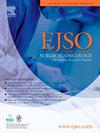Long-term functional outcomes after Transanal Transection and Single-Stapled (TTSS) anastomosis for rectal cancer measured by electronic Patients Reported Outcome Measures (ePROMs)
IF 3.5
2区 医学
Q2 ONCOLOGY
引用次数: 0
Abstract
Background
The transanal transection and single-stapled anastomosis (TTSS) is gaining interest as a reconstructive technique whenever a restorative procedure after a total mesorectal excision (TME) is planned. TTSS, allowing lower anastomoses than the conventional DS technique, may raise discussion about its functional outcomes. The aim of this study was to compare long-term functional outcomes of TTSS and DS techniques performed after TME for rectal cancer (RC).
Methods
This was a prospective, observational, two-parallel cohort study. Consecutive patients undergoing stoma closure after TME for RC with either TTSS or DS approach were included. The Low Anterior Resection Syndrome (LARS) questionnaire was delivered at 6, 12, and 24 months after stoma closure through a web link embedded in a Short Message System (SMS) or email using an electronic system (Esosphera Srl).
Results
According to sample size calculation, 116 patients (58 per cohort) were included. No difference in the LARS score was found at 6 and 12 months, while a significantly lower median LARS was reported in TTSS cohort at 24 months (p = 0.034). The rate of patients with LARS and LARS sub-domains were comparable except for a lower fractioning in TTSS at 24 months (p = 0.005). Anastomoses in the TTSS cohort were significantly lower (p = 0.027), anastomotic leak rate was higher in the DS (p = 0.016).
Conclusions
Although lower anastomoses in TTSS cohort, functional outcomes were not inferior of those after DS technique.
电子患者报告结果测量(ePROMs)测量直肠癌经肛门横断单钉吻合术(TTSS)术后的长期功能结果
背景:每当计划在全肠系膜切除术(TME)后进行恢复性手术时,经肛门横断和单钉吻合术(TTSS)作为一种重建技术越来越受到关注。与传统的DS技术相比,TTSS允许更低的吻合口,可能会引起对其功能结果的讨论。本研究的目的是比较直肠癌TME (RC)后TTSS和DS技术的长期功能结果。方法前瞻性、观察性、双平行队列研究。连续接受TME后闭合造口的患者采用TTSS或DS入路。低位前切除术综合征(LARS)问卷在口闭合后6、12和24个月通过嵌入短消息系统(SMS)的网页链接或电子系统(Esosphera Srl)的电子邮件发送。结果根据样本量计算,共纳入116例患者(每队列58例)。6个月和12个月的LARS评分没有差异,而在24个月的TTSS队列中,LARS的中位数显著降低(p = 0.034)。除了24个月时TTSS的比例较低(p = 0.005)外,LARS和LARS子域患者的比例具有可比性。tss组吻合口瘘发生率较低(p = 0.027), DS组吻合口瘘发生率较高(p = 0.016)。结论虽然TTSS组吻合口较低,但功能结果并不差于DS组。
本文章由计算机程序翻译,如有差异,请以英文原文为准。
求助全文
约1分钟内获得全文
求助全文
来源期刊

Ejso
医学-外科
CiteScore
6.40
自引率
2.60%
发文量
1148
审稿时长
41 days
期刊介绍:
JSO - European Journal of Surgical Oncology ("the Journal of Cancer Surgery") is the Official Journal of the European Society of Surgical Oncology and BASO ~ the Association for Cancer Surgery.
The EJSO aims to advance surgical oncology research and practice through the publication of original research articles, review articles, editorials, debates and correspondence.
 求助内容:
求助内容: 应助结果提醒方式:
应助结果提醒方式:


